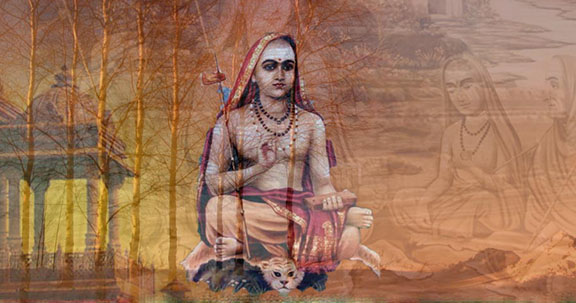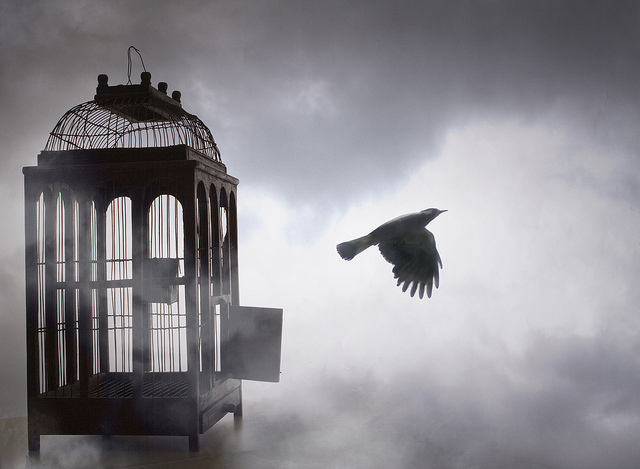Brahman, Pure Consciousness, is the Absolute Reality. The world is unreal.
Adi Shankaracharya, the ultimate rebel, is considered to be an ideal Sannyasi. It is commonly accepted that he lived about one thousand two hundred years ago though there are historical sources that indicate that he lived in an earlier period. He was born in Kalady, Kerala and in his short life span of 32 years, his accomplishments seem a marvel even today, with our modern conveyances and other facilities. At the tender age of eight, burning with the desire for Liberation, he left home in search of his Guru. Adi Shankara was an intellectual giant, a child prodigy, and above all, an ever-shining spiritual light. The level of wisdom and knowledge he showed at a very early age made him a shining light for humanity.
People tend to forget that seer Adi Shankaracharya was a great Raja Yogi as well, one of the purest we’ve known. Shankara discusses all the main aspects of Raja Yoga in his books and shows that he knew the secrets of the chakras, mantra, pranayama, concentration and meditation, as well as the intricacies of Nirvikalpa Samadhi, the highest yogic state.
Shankaracharya, the teacher, is one of the greatest spiritual masters in the history of India. Shankara has often been called the greatest philosopher of India, if not of all time and the entire world. His teaching is highly rational, clear and concise, as well deeply mystical, unfolding all the mysteries of Self, God, the universe, the Absolute and immortality. Most of what today is called Advaita (non-dualistic) Vedanta reflects the mark of his insights. He is the main classical teacher of the Advaita Vedanta tradition.
Shankara’s greatness has been hailed by such monumental modern gurus of India like Swami Vivekananda, Swami Sivananda of Rishikesh, Ramana Maharshi, Maharishi Mahesh Yogi and Paramahansa Yogananda, to name a few. In fact, most of what Ramana Maharshi and Nisargadatta taught as Advaita is pure Shankara’s Advaita. Perhaps more notably, most of the original Yoga that came to the West starting with Vivekananda was styled “Yoga-Vedanta,” reflecting Shankara’s influence, and aimed at Self-realization through meditation, not simply at skill in asana practice. Indeed Shankara has been a more dominant figure than Patanjali in for these great Yoga-Vedanta masters and for India as a whole historically.
Shankara is the main traditional teacher of Jnana Yoga or the “Yoga of Knowledge,” which is usually regarded as the highest yogic path. Even Patanjali states that liberation or Self-realization is gained by knowledge, not by any other means and makes Yoga a means of achieving that higher knowledge. Shankara’s many written works, including extensive commentaries on the Upanishads, Bhagavad Gita, and Brahma Sutras, and shorter philosophical works like Vivekachudamani or the Crest Jewel of Discrimination remain the core teachings behind Jnana Yoga even today.
Shankara’s great poem Saundarya Lahiri or the Wave of Bliss remains the most famous work of Tantric Yoga and Shakti Sadhana reflecting all the secrets of Sri Vidya, mantra, yantra and Tantra. In addition, Shankara composed beautiful chants to the Hindu Gods and Goddesses that remain repeated and sung today probably more than any other poet. These include chants to Shiva, Sundari, Vishnu, Lakshmi, Sarasvati, Rama, Krishna and Ganesha. In these hymns, he shows that he also mastered all the intricacies of Bhakti Yoga or the Yoga of Devotion and was not a mere dry philosopher. The musical cadence of some of his chants like Shivo’ham, or “I am Shiva,” has entered into the western kirtan movement as well.
Shankara is usually dated to the eighth century by western scholars but is placed much earlier by most Indian scholars. Though he lived only to the shortage of 32, he left a legacy of teachings, temples and lineages that affected the whole of India and marked an entire era.
Shankara’s non-dualistic Raja Yoga
It is often highlighted, particularly by academics, that Shankara does refute Samkhya-Yoga philosophy, particularly in his commentaries on Vedic texts, and so appears to be against Yoga. This is a misunderstanding. It is not the practice of Yoga overall that Shankara criticizes but the ideas of Purusha and Prakriti as separate realities and that the Purushas are many, which do occur in Samkhya and Yoga Sutra philosophy. Counter to these ideas, Shankara proclaims Kevala Advaita or pure unity as the highest reality instead.
Shankara has a slightly different view of Raja Yoga than the philosophy of Samkhya or Patanjali and teaches his own system of Raja Yoga based upon Advaita or the non-dualistic view. It is not Yoga per se that Shankara refutes, but simply the dualistic aspects of Samkhya and Yoga philosophy, which are arguably not their real implication, or necessary for the practice of Yoga overall, which after all aims at unity consciousness. Shankara never criticized the Yoga of Sri Krishna in the Bhagavad Gita but promotes it strongly.
Specifically, Shankara taught a fifteenfold Raja Yoga in his important short work Aparokshanubhuti. Aparoksha refers to the knowledge gained by the direct perception in consciousness itself, which is beyond both reason and sensory perception. Anubhuti is the experience of that from moment to moment as the ground of one’s own being. This is the knowledge born of Samadhi that is the highest form of knowledge.
Shankara and Jnana Yoga bring clarity to the higher goal of Yoga. Shankara states that Self-realization requires knowledge, not merely Samadhi and that this knowledge rests upon inquiry or vichara, which is a higher mental activity, not simply actions like asana or pranayama, which have value more for purifying the mind and body than for the direct realization of the Self. This means that one can practice asana and pranayama forever and still not gain liberation, though these practices may aid with physical health and psychological well-being. We must move beyond them to deeper meditation.
Even meditation cannot bring us Self-realization unless it is allied with a deeper inquiry or vichara, meaning meditation on the Self, rather than on other objects or ideas. On the other hand, without deep meditation, vichara or inquiry is not enough either, as it can remain merely at a conceptual level. In this regard, Shankara teaches his fifteenfold Raja Yoga to aid in the realization of the knowledge generated by vichara or inquiry, and as a deeper level of inquiry. Clearly the role of knowledge and vichara has not been given its proper central place in most of modern Yoga. Shankara teaches us how to bring it back.
It is this intellectual clarity with which he expressed himself and the zest and energy with which he spread it across generations and time, that make Adi Shankara stand out. One aspect that is very important in today’s world is that all this knowledge, all this wisdom came not by faith or belief, but by realization. Unless the spiritual process is in some way in sync with fundamental human logic and current scientific findings, people will not take it. Future generations will reject anything that does not make logical sense to them, and is not scientifically correct. In this context, Adi Shankara is very significant today as he was 500 or 800 years ago.
Adi Shankara is probably the rarest of beings to be celebrated by different bodies of Yoga. Bhakti yogis, Gnana Yogis and Raja Yogis consider Adi Shankara as their Alumni and their ultimate master.


